Graham Dawes, M0AEP/VP2MDD
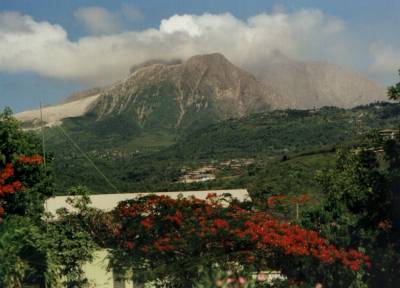 The volcano, from the VP2MDD QTH
The volcano, from the VP2MDD QTH
Montserrat was relatively unknown until Summer 1995 when it was catapulted into the world’s media by the Soufriere volcanic eruption. There followed dramatic stories and pictures of destruction. I was on the island at the time together with my wife and sons, then aged nine and ten, sharing with the local population the fears and uncertainties that accompany such events.
When we returned to the UK from that trip we did not know when, or if we would return to the island that had been our regular holiday destination for over 15 years.
We made our first return to Montserrat last June and it was a very different Montserrat that we found. The southern part of this beautiful small Caribbean Island is totally evacuated, including the ex-capital Plymouth. Many people have lost businesses, homes and possessions. Some have evacuated to other Caribbean countries, the USA or the UK. The population has been reduced from 11,000 to about 4,500 who all now live in the Northern Zone, which is considered safe by the resident Montserrat Volcano Observatory staff.
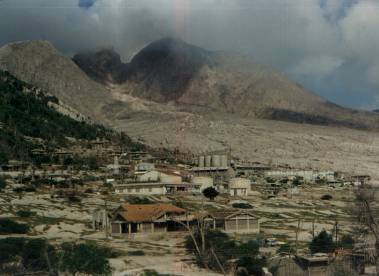 The
northern outskirts of Plymouth show clearly how mud and ash flows from the
volcano entirely covered buildings (in the background)
The
northern outskirts of Plymouth show clearly how mud and ash flows from the
volcano entirely covered buildings (in the background)
The amateur radio population has also declined. Indeed there is a weekend net on 10 metres and 17 metres just to keep ex-VP2M stations in contact. Apart from visiting amateurs, there are only a few local stations active on HF at the moment (19th Dec 1999). VP2MU, VP2MBR, VP2MGR, VP2MEE have all promised me contacts on 10 metres this winter! Unfortunately there is no six metre activity by resident stations.
Our home has splendid views of the volcano about four miles to the south-east and of the ocean to the south and west. Whilst the volcano was stated as being officially in decline and cooling down when we left in September, we returned on 1st December 1999 to be told that there was now more dome growth taking place again.
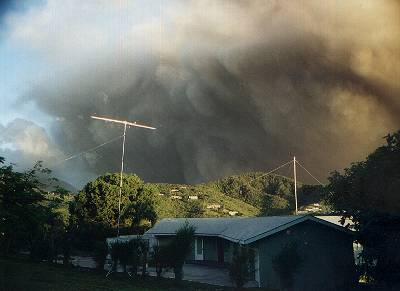 An
early evening ash eruption seen from the VP2MDD QTH, with the six-metre yagi and
Windom support mast in the foreground.
An
early evening ash eruption seen from the VP2MDD QTH, with the six-metre yagi and
Windom support mast in the foreground.
We could see a lot of steam and smoke coming from behind the visible cordillera peaks. This material was attributed to the new dome which is growing fairly quickly. We experienced ash eruptions in July and December. The July eruption totally engulfed our location, turning brilliant daylight to absolute blackness for about seven minutes and leaving deposits of ash everywhere. In December we were fortunate that the prevailing wind took the ash eruption down towards Plymouth towards the south. Nevertheless it was an awesome majestic sight and made for unique photographs. You soon learn to totally close all doors and windows when going out or before retiring at night! Similarly, all my radio equipment and lap-top was covered when not in use as dust gets everywhere.
During the summer, Six was very quiet from Montserrat. Using 100 watts to a four-element yagi at 26 ft agl, only 55 QSOs were made mainly with SE USA and other Caribbean countries e.g. the Cayman Islands, Jamaica, Belize, Panama, Honduras, St Kitts, Nevis, Anguilla, Puerto Rico. But no long distance contacts were achieved. Frustratingly, ten metres was superb with over 2000 world-wide contacts being made with 90 watts and a 34ft Windom about 17 ft agl.
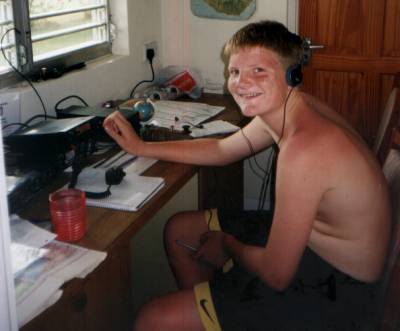 Junior
op Philip performed hours of 50MHz monitoring at VP2MDD
Junior
op Philip performed hours of 50MHz monitoring at VP2MDD
The story in December was very different! This time it was the turn of Six to open up regularly via TEP into South America nearly every evening. Between 2300 UTC (about an hour after sunset in VP2M) and 0300 UTC I experienced propagation to grid fields FE, FF, GF, GG, FG, GH, GI, FI and FJ. A knowledge of Spanish / Portuguese might have helped improve on the 300-plus QSO’s. I tried CW, which helped but I had the impression there were many non-CW stations on Six taking a relatively rare opportunity to exercise their English. Thank you all for your patience!
Unusual QSOs included CE3SAG in Santiago on FM, and an LU mobile 700 km south of Buenos Aires using 8 watts to a car vertical with whom I exchanged 5/7 reports. A new prefix for me was OA8ADM who was /MM in his 42ft boat ‘Ambassador’ way up the western Amazon river near Quito. Larry’s IC706 and R5 put a 5/5 SSB signal into Montserrat.
My daytime work schedule probably prevented me participating in openings to the USA. In one brief opening stations were worked from EN, FM, EM and EL fields. On Saturday 4th December the VO1ZA beacon was copied and peaked on a heading of about 040 degrees as opposed to 010 which was the theoretical direction.
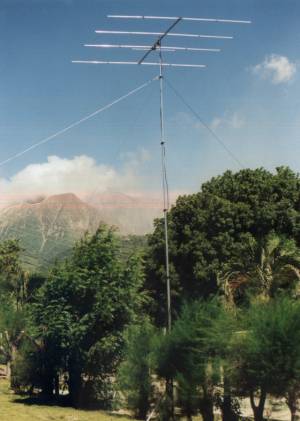 I
think we all know what this is!
I
think we all know what this is!
The following Saturday, whilst putting out a CW CQ to EU at 1916 UTC on heading of 040 I heard a very, very weak CW signal almost like backscatter and copied the letters V,S and L. No reply was heard to a QRZ call. I later received an e-mail from Steve VE7SL saying he copied my signals at this time (which were beamed at EU) and tried to call me using high power CW. This would probably have explained the reply I heard. Unfortunately my four-element yagi is hand-rotated, otherwise a QSO might just have been possible.
During this visit I did manage to erect a 20ft lattice mast with an extending 18ft pole. Hopefully the next visit should see the opportunity to install a rotator on the pole. Due to the destructive nature of the potential ash falls this will have to be removed at the end of each trip.
Beacons heard fairly regularly were XE1KK, YV4AB, HC2FG (later worked), LU9EHF (also worked), ZD8VHF, ZP5AA and PY1AA. PY stations reported hearing a beacon signal from Libreville and also Okinawa but I did not hear either.
This was my most successful session on Six from Montserrat so far. Despite the volcanic situation this is still a beautiful island with very friendly people. It made up for the lack of activity from my home QTH which has been curtailed by our recent move.